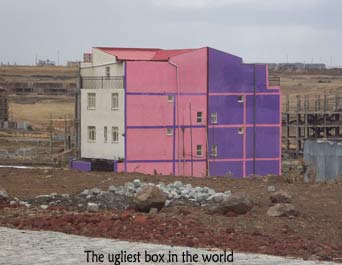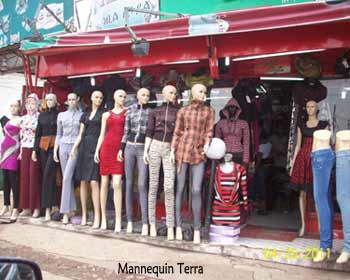Addis Ababa And Djibouti: Mannequin And Plastic
![]()
In the last edition of Negarit, I lamented the sad situation of Assab, and the sadder situation of the people of that region who are denied job opportunities in their own country by a reckless policy of the dictator and his enablers. I was going to leave it at that, but the events of the last two weeks added salt to the wound; Massawa is headed towards the tumbleweed state of Assab.
Years ago I worked in a port and I have modest knowledge about port entry procedures: how and why ships enter the territorial waters of a given country, etc. The drama of the British security boats and their personnel who were jailed for six months was not only embarrassing for Eritreans, it will probably define Massawa port for years to come. Who in his right mind would want to use Eritrean ports as long as the PFDJ is there?
Massawa and Assab had a big potential to attract business from the thousands of ships that crisscross the Red Sea: there are fuelling stops, ship chandelling, catering, maintenance (including dry-docking), which any port worth its salt in a busy waterway like the Red Sea tries exploit. Vessel captains and their bosses do what all businessmen and tourists do when they choose their destination: they assess the benefits.
In the sixties, and early seventies, tens of ships used to dock in Massawa after dropping Haj pilgrims in Jeddah, which was then a small port compared to Massawa. The port city was busy and ships and their sailors were spending a lot of money in Massawa.
Businessmen also assess the risks associated in accessing those services: is Eritrea a land of law? Are its authorities corrupt? Are the authorities hostile? Is the business transaction efficient or laborious? Is the place safe? Now, if you had a ship that was stranded in the Red Sea, would you send it to an Eritrean port? Would you think of getting your catering and other services from Eritrea? Of course not—the thorny officers and unfriendly regime’s attitude will not encourage you to do that. You will look for another friendly port, while Massawa decays just like Assab is decaying. And the people lose the opportunity of employment; businesses lose the opportunity to make and reinvest profits and their contribution to the growth of the national economy evaporates.
Now you have the Hasad PFDJ which celebrates if two ship dock at Massawa. But that is not my main topic today… it is Djibouti and Ethiopia
Could We Be Heading To Assab?
My flight from Djibouti to Addis had to do a stopover at Dire Dawa (Dire Daba as the Somalis call it.) The pilot kept flying around the city for a long time in high altitude. Finally he announced the reason: “bad weather conditions, we are trying to approach the runway from a different direction.” Then he headed towards what seemed to me north east, and Asseb I guessed Assab is only half an hour or less in that direction. I fished the flight magazine to check the map: Assab is close. Even if he went to Assab, there would be no one at the dead airport; I imagined you could land and take off before anyone came from the AlShabab training camp at Kiloma, or somewhere around there. I was in the middle of my imagination when the pilot decided to fly to Addis because the fuel was running out….now I had to console a man sitting beside me. A few minutes ago he was happy he was close to his home, Dire Dawa, now he had to fly to Addis and will have to fly back to Dire Dawa the next day. It was already too late; and there are no night flights to Dire Dawa and he had to wait for the next day. I arrived safely, albeit late, at Addis Ababa.
On my way to Djibouti, I only stayed for one night in Addis—it was late and power was off and I didn’t get to see anything. Now on my return, I will get to observe the city and see the difference since I last visited three-years earlier. And this is what I observed:
Addis New York Ababa
 All right, it is no news that the real estate development is a phenomenal activity in Ethiopia. The builders are copying New York architecture, and maybe overdoing it—it seems Ethiopian architects believe that a building should be 50% glass and 50% concrete to be considered modern! Who cares about power conservation, or even the comfort of those who live or work in those buildings? If the temperature gets hot and stuffy, you just cut through the walls and add an ugly air conditioner with all that goes with it, mainly pipes that obviously were not in the original design of the buildings. It is an eye-sore, ugly. A few shinny buildings that impressed me so much three years ago look like a graffiti wall in a New York subway.
All right, it is no news that the real estate development is a phenomenal activity in Ethiopia. The builders are copying New York architecture, and maybe overdoing it—it seems Ethiopian architects believe that a building should be 50% glass and 50% concrete to be considered modern! Who cares about power conservation, or even the comfort of those who live or work in those buildings? If the temperature gets hot and stuffy, you just cut through the walls and add an ugly air conditioner with all that goes with it, mainly pipes that obviously were not in the original design of the buildings. It is an eye-sore, ugly. A few shinny buildings that impressed me so much three years ago look like a graffiti wall in a New York subway.
Looking at the shop front signs, I thought they brought all the graffiti artists from New York—or maybe the Addis municipality considers graffiti an advertising. Well, beautiful buildings look so old and misused with the tasteless front signs, in ugly colors that have no harmony and no taste at all—digital poster and banner printing is flourishing in Addis, and it is being abused.
I would have thought Addis has an architects club or some entity that overlooks into such matters; and they must certainly have city ordinance; but I don’t think they are enforcing it! There is a murder of taste going on.
Addis Ababans Read A lot Of Newspapers!
Sitting in one of the many coffee shops on the street close to the Ghion Hotel, I was amazed at the number of young boys selling newspapers and the number of people reading them. Wait a minute: I also noticed something funny. It took me a few mornings to find out what was really happening—they rent newspapers in Addis. Many were just reading the newspapers and as they leave, they return them to the sellers with a few coins. Then again, the vendor either sells or rents the papers to another customer. Clever. Why buy a newspapers and throw it away when you can rent it for a few coins? Newspaper publishers: watch that racket that is going on every morning in the coffee shops of Addis.
Thank You China!
One morning, as I sat sipping cappuccino—dammit, they are beating Eritreans at making that as well—a very funny man walks in and starts a conversation with me. He said he was an artist, azmari, a hip hop poet. I thought he was bluffing, but he proved me wrong. He told me that Africans are enamored with the Da sound. Da! How so?
Let’s begin with Kenneth Kaunda,
Then we go to Uganda
Whose president was Idi Amin Dada,
Even Ethiopia has Negassu Gidada
Malawi has a president named Hastings Banda
And Nigeria had Ibrahim Babangida
Mauritania had Ahmed Ould Dada…
He kept spewing African names ending with da like a machine gun. And they were intelligently composed, my English translation doesn’t give justice to his compositions. No wonder the Russians made headway with African revolutionaries: the Russian word for “yes” is “da.” Duh!
Then he asked me, “I haven’t seen you around here before!”
Engda negn!
The first time I went to Sudan, I saw many sharply-dressed people with gold chain necklaces and holding small purses. You could easily identify them from the locals and I soon discovered they were mostly recent Eritrean migrant workers from abroad visiting.
It was like that in Ethiopia even three years ago—you could tell the locals from the hyphenated Ethiopians easily. They dressed sharply, had a lot of glittering gold on them. This is in contrast to Ethiopian women who have this ability to dress sharply and look fashionable even if they are poor. The men were as shabby as the word itself. But this time I couldn’t tell between the locals and the visitors—everyone was dressed Chinese. In the stalls of Mercato or Piassa, one would find a jacket better than the one bought from the best stores in the USA. Don’t expect someone to ask you ‘Where are you from?’ You are no more identifiable by the clothes you wear or the shoes you have on.
The locals are probably better dressed than you and all you have to do is quietly blend with the crowd, all wearing Chinese pants, shirts and jackets. And no one would tell if you are from Washington DC, London or Dembidolo.
But China didn’t become the dress code equalizer of the world just like that; it smartly exploited the tasteless dress code of the USA that influenced everyone to wear basketball shorts and and saggy jeans; and for some reason, an Ethiopian with saggy pants is the ugliest scene ever.
Mannequin Tera
 Where is Mannequin Tera? All the streets of Addis are mannequin tera. I asked a storekeeper where the mannequin factory was located; he said there isn’t one in Ethiopia, they import it from elsewhere. Why? If mannequins are that popular, someone has to open a factory and manufacture them there. Small investors: there is a business project for you. A store that has a dozen pants to sell, eight are on mannequins outside the store and four pants on the shelves. No kidding. It seems as if one must have twenty mannequins to get a license to open a clothing store. The displays are so surreal: everywhere you go, there are armies of mannequins like Buckingham Palace guards, standing in attention. Store front design and merchandizing service would be another business opportunity.
Where is Mannequin Tera? All the streets of Addis are mannequin tera. I asked a storekeeper where the mannequin factory was located; he said there isn’t one in Ethiopia, they import it from elsewhere. Why? If mannequins are that popular, someone has to open a factory and manufacture them there. Small investors: there is a business project for you. A store that has a dozen pants to sell, eight are on mannequins outside the store and four pants on the shelves. No kidding. It seems as if one must have twenty mannequins to get a license to open a clothing store. The displays are so surreal: everywhere you go, there are armies of mannequins like Buckingham Palace guards, standing in attention. Store front design and merchandizing service would be another business opportunity.
If I am identifying business opportunities for Ethiopians, I would begin with interior designers and decorators. They could do well, not the sophisticated type, the simple and basic. You enter into any important office, mostly government, and they have this obsession with hanging picture frames so high close to the ceiling. If you want to see the pictures closely, you risk a neck injury called qenno, a neck muscle inflammation from looking up to see a picture in a frame. I am not telling where I saw that, I do not want to anger some people high up in the system, and western educated business people…many of them. Here is a simple rule (the frame issue in Ethiopia is so bad I am allowed to pontificate): Eye level—and I think that is basic. if you have the middle of the frame at eye level, you are fine—and you do not have to guess how high eye level must be: anywhere from 1.5 to 1.75 meters is fine. I am a do-gooder, I am telling you even if you might not like it; others would simply say you are tasteless and gossip about it at every occasion. All right, that is Bourgeoisie stuff, but so is business!
Then there is one more annoying thing in Addis; just like most developing cities: you can’t have a decent walk on the sidewalks. No one knows where the boundaries of cars, pedestrians, stores and street vendors begin or end—it is another Badme. The pedestrians are always losing, others are free, they can encroach on any boundary they want—a car can be parked on a pedestrian walkway; women may decide to wash the laundry on the same walkway, a guy might put a stall to sell—well, anything, including phone cards. What do the pedestrians do? They consider themselves cars and walk in the middle of the street—all right, this is no pontification, Ethiopians know this—but they are not solving it, it is getting worse with the growth of the population and the growing economy. If this is difficult to solve, I have an idea: give people license numbers so that they stick it on their back, and everything will be fine. Otherwise, pedestrians need to liberate their sidewalks.
The Djiboutian Plastic Landscape
There is nothing to talk about concerning fashion in Djibouti, because it is very difficult to be fashionable in a hot place (going naked is not fashion) but I am going to tell you about plastic waste.
If you throw plastic on the desert, you grow more plastic and you have a fine plastic harvest. No? Then where are the millions of plastic bags strewn (and why) on the desert coming from?
Outside the port city, the rest of Djibouti looks like a plastic bag waste area. I have never seen so much plastic in any place—the entire desert is covered with plastic bag litter. Maybe someone told them plastic is bio-degradable. But they should know it is not so, the plastic is just there moving like a crowd of nomads from one place to another thanks to the wind.
I wish the Ethiopian mannequins could be employed to chase the Djibouti plastic bags—at least it would be entertaining.
You remember the AlMektoum road that I mentioned in my last edition? If you drive on the road that runs alongside the northern fence of the port and then turns left towards Bibila–that is the one. Both sides of the road seem like a plastic bag dumping area and the litter extends as far as the eyes can see…they flap and fly like seagulls all over the area. I am afraid soon, Djibouti will not have anymore sand, it will be covered in plastic. Worse, I suspect foul play (read corruption) because I saw countless empty grain sacks discarded there. Where is the wheat? It is obvious something left the port inside the sacks, now the sacks are discarded. Where is the wheat?
Finally, my observation about the two countries are written in a friendly spirit, of a neighbor visiting, and I hope they are taken as that.
I am grateful for the people of the two countries and I wish them all the prosperity and success and I look forward to the day that peace and cooperation would be built in the region on the ashes of belligerence and instability—I hope that soon, Eritrea will be at peace with itself and with its neighbors. And I hope soon Ethiopians and Djiboutians will visit Eritrea and share their observations with the public. By then I am sure you will see how beautiful and nice most Eritreans are; and you will feel sorry they had to suffer under a tyrant like Isaias for this long. Once the Isaias era of oppression is over, there will be a museum showing the damages he did to Eritreans over of the last twenty years.
Saleh “Gadi” Johar is the author “Of Kings And Bandits.” Order it at www.negaritmedia.com




Awate Forum